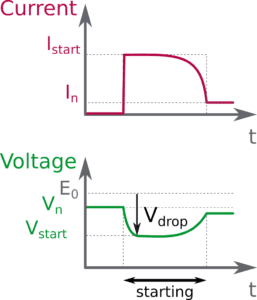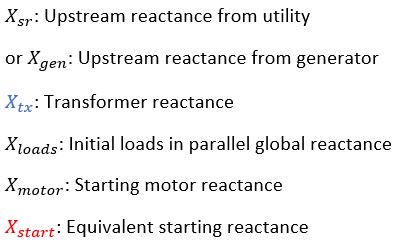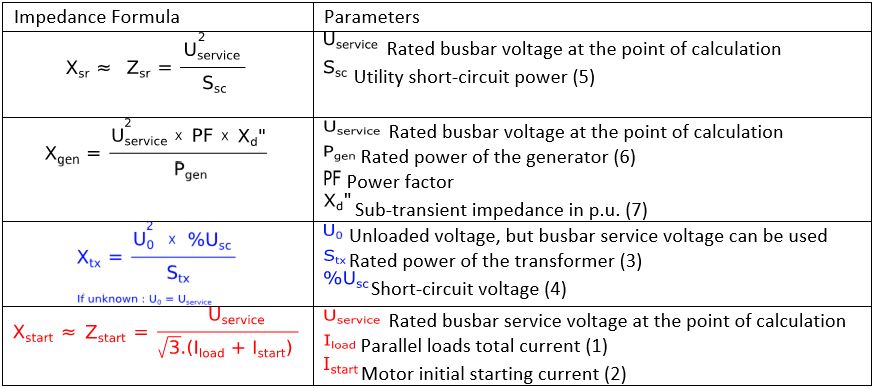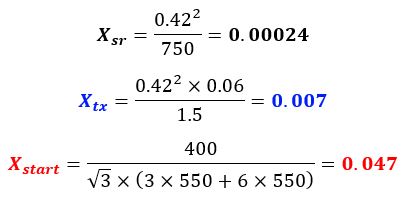Avoid electrical network stress during large motor starting using simplified calculations at design stage
Credit to Author: Jerome Guillet| Date: Mon, 20 Jan 2020 14:16:07 +0000
This post is part of a series of motor management blogs that discuss different aspects of large motor integration in the electrical network and industrial process.
Voltage drop during load energization is a major concern in heavy industries. Furnaces, transformers, and large motors are examples of loads with high inrush currents, generating voltage drop. In the same time motors exposed to voltage drop will have their torque reduced, experiencing deceleration and even stalling. Sensitive electronic devices can fail when voltage drop occurs. To cope with these issues, voltage drop protection is used to disconnect loads at a defined threshold. If voltage drops are not addressed in the design phase, they may later be responsible for process downtime and production losses.

Figure 1 Motor starting current and generated voltage drop
For large motors, it is best to address the issue as early as possible in the early design stage of a project. However, at this stage fewer inputs are available, so this can be challenging.
That is why, quick simplified calculations can be relevant, compared to time-consuming simulations based on multiple assumptions.
A simple method of calculation is to focus only on predominant reactances, neglecting resistances, and consider the electrical network as an impedant circuit. This method is valid if cables can be omitted.
Consider the following electrical network with one starting motor:

Figure 2 Equivalent circuit of a starting motor with initial loads in parallel
Where,

Based on the figure above, the starting voltage and voltage drop can be expressed as:

Several parameters can help to maintain a high starting voltage and reduce the voltage drop during starting.
These parameters are shown in the next table:

Effectively, limiting the voltage drop, Vdrop, is possible through:
Increasing equivalent starting reactance ![]() with:
with:
- A load current (1) decrease by disconnecting or reducing loads before starting a large motor. This method is limited to specific processes (oil and gas, mines, etc.) and exceptional starting (one start/year) of very large motors (>10MW). This is a process automation-based solution.
- A motor starting current (2) decrease using starting equipment. This method brings the additional benefit of mechanical stress reduction. Starting current (2) can also be reduced with a specific low inrush current motor, which can be a more economical solution than using a starter.
Reducing transformer reactance ![]() with:
with:
- Higher transformer power (3) and/or lower short-circuit voltage (4)
Reducing upstream utility or generator reactance ![]() with:
with:
- Verify utility short-circuit power (5) with effective inputs. Underestimating the value could have economic consequences due to pessimistic evaluation of starting voltage drop.
- An increase of generator power (6) or design of the generator with lower sub-transient impedance (7).
Case study:
Let’s consider the example of 4 x 315kW 0.4kV 550A motors supplied through a 1.5MVA 22/0.42kV transformer with a 6% short-circuit voltage and 750MVA upstream short-circuit power.
For one motor starting at 6 x In with 3 similar motors that are fully loaded and running in parallel, the variables can be calculated as:

Then the voltage during start can be calculated as:

Coming next in our blog series: How to estimate voltage drop with large motor starting.
Interested to learning more about motor management? Let our expertise be your guide in this free brochure:
Motor Management for LV and MV high-power motor applications
The post Avoid electrical network stress during large motor starting using simplified calculations at design stage appeared first on Schneider Electric Blog.
